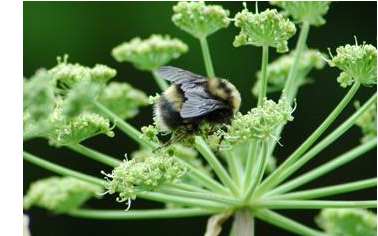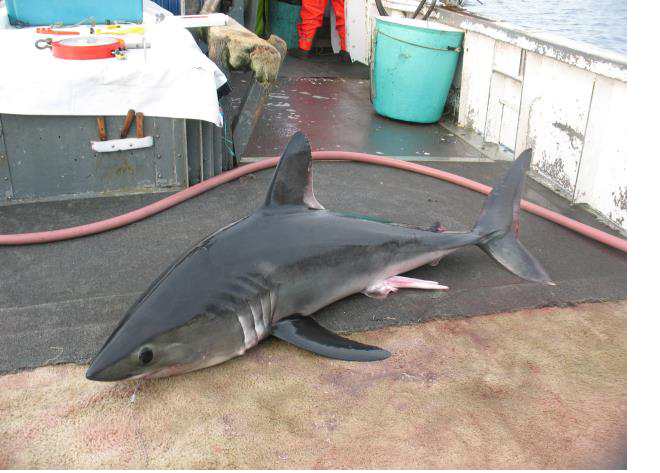Twenty-seven Canadian wildlife species were assessed as at risk at the recent meeting of COSEWIC (Committee on the Status of Endangered Wildlife in Canada), held April 27th – May 2nd, in Halifax, Nova Scotia. Since 1978, COSEWIC has assessed nearly 700 wildlife species as at risk. When the Species at Risk Act (SARA) came into force in 2003, COSEWIC was given the responsibility of providing scientific species assessments to the Minister of the Environment to inform government decisions for protection of species at risk under the Act. Five hundred and eighteen of the species assessed as at risk by COSEWIC are now listed under SARA.
Canada’s pollinators at risk

Two bee species were assessed as at risk at this meeting. Some groups of bumble bees are experiencing dramatic declines worldwide that are not well understood. Suspected causes include impacts from pesticides, pathogens, and human-induced climate change. This downturn is bad for the bees and bad for us. Bees pollinate more than 70% of our crops, and without the services that they provide, our food supply is at risk. Western Bumble Bee was widespread in Canada, but it has undergone a mysterious decline. The southern population of Western Bumble Bee has been reduced in some areas, resulting in a Threatened status. While the northern population appears to be in better shape, declines are known in some areas, and our lack of understanding of what drives bee declines is a cause for concern. The Gypsy Cuckoo Bumble Bee, though less abundant, also used to be widespread across Canada. Despite an increased effort to find this species, none have been seen in Canada since 2008, and it was assessed as Endangered. Cuckoo Bumble Bees have an intriguing way of life: a female invades the hive of another bumble bee species and takes over after removing the queen. There may still be small numbers that have not been detected recently, but it is troubling that such a widespread species should decline so drastically without any clear explanation.
Coldwater shark still in hot water

The Porbeagle is one of 28 species of sharks that occur in Canada. This large-bodied species makes extensive migrations from Canadian waters to the mid-Atlantic. Porbeagle sharks are caught in Canadian and international fisheries both for their fins and their meat. Due to overfishing, the abundance of this shark declined greatly in the 1960s, partially recovered in the 1980s and then collapsed again in the 1990s. The number of sharks remains at about 30% of their 1961 level, and the species was once again assessed as Endangered by COSEWIC. Although fishing licenses for this species were suspended in 2013, they are still caught as bycatch in the tuna, swordfish and groundfish fisheries. COSEWIC first assessed the Porbeagle as Endangered in 2004, but it was not listed on the Species at Risk Act because of the economic losses that would result from suspending the fishery. More recently, Canada supported listing the species under CITES, an international agreement that regulates trade of endangered species. This new CITES listing provides tools to ensure that international trade does not harm the species. Taken together, the CITES listing, COSEWIC’s finding that the shark remains Endangered, and the suspension of the directed fishery for Porbeagle, may signal that this majestic fish will finally get the help it needs.
Wolverine population retreating northward
Although most Canadians have never seen one, Wolverines used to be one of the most widely distributed animals in Canada, with a range that blanketed all three territories, all of western Canada, the prairies, Ontario, Quebec, Labrador and New Brunswick. The range of these secretive carnivores shrank considerably in the early 1900s, and they are no longer known from regions highly modified by humans, especially in southern Canada. Although often subject to high levels of hunting and trapping, this elusive carnivore receives little attention and monitoring. As a result, we have a poor understanding of how populations are faring under climate and land use change. COSEWIC assessed the Canadian population of Wolverine as Special Concern due to increasing industrial activity and greater access to its remote habitats because of new roads and increasingly sophisticated snowmobiles. Because Wolverines are sensitive to human activity, especially when denning, local populations may not recover from declines or re-populate vacant habitats.
Mountain caribou increasingly imperilled
The iconic Caribou, like the Wolverine is known from most parts of Canada. But in the case of Caribou, featured on the Canadian quarter, there are many distinct groups with unique combinations of genetic features and life history traits, resulting in the recognition of more than a dozen distinct population groups. All will be assessed by COSEWIC over the coming years, some for the third or fourth time. At this meeting, three of these population groups were assessed: Southern, Central and Northern Mountain Caribou. Together these include about 70 herds in the mountains of western Canada, from southern British Columbia and Alberta to Yukon and the Northwest Territories. Having lost 30% of their range since the early 1900s, the condition of many herds has been deteriorating at an accelerating pace because of dramatic habitat changes and disturbance from industrial development, human settlement and recreation.
Southern Mountain Caribou in southeastern BC were last assessed by COSEWIC as Threatened in 2002. Since then, they have declined by 30% and two herds have disappeared. Of the 15 herds comprising the Southern Mountain Caribou, 9 currently have fewer than 50 adults, and 6 herds have fewer than 15. They were assessed as Endangered at this meeting.
The situation is even more dire for Central Mountain Caribou in the Rocky Mountains of Alberta and BC, which have declined by 60% in the past 10 years. They were also assessed as Endangered. Many of the Central Mountain Caribou herds occur in protected areas and parks, including Jasper and Banff National Parks. Unfortunately, even in protected areas they aren’t doing well. The last five caribou in Banff died in an avalanche in 2009.
Northern Mountain Caribou range from west-central BC to Yukon and western Northwest Territories; the condition of most of the 45 herds is unknown, but 9 in the southern part of the range are known to have declined by 26% in the last 10 years. Northern Mountain Caribou were assessed as Special Concern due to increasing concerns for the welfare of all herds, which face escalating industrial development, even in currently remote regions.
What will it take to save Copper Redhorse?
Canada’s extraordinary biodiversity also includes some species known from nowhere else, one of which, the Copper Redhorse, even has a beer showcasing it, with part of the proceeds targeted to species at risk recovery. The Copper Redhorse is a fish that spawns in just one river in southern Quebec where it is threatened by habitat degradation, pollution, exotic species and fragmentation by dams. Copper Redhorse is slow to mature and long-lived. The spawning population is aging, and with few young being produced, it is expected to disappear rapidly unless conservation efforts succeed in rebuilding the population. This fish was assessed as Endangered at this meeting.
With such a small distribution, the Copper Redhorse is naturally vulnerable, but many of the other species assessed at this meeting illustrate that even our most widespread species are susceptible to becoming at risk.
Next meeting
COSEWIC’s next scheduled wildlife species assessment meeting will be held in Ottawa, Ontario in November 2014.
About COSEWIC
COSEWIC assesses the status of wild species, subspecies, varieties, or other important units of biological diversity, considered to be at risk in Canada. To do so, COSEWIC uses scientific, Aboriginal traditional and community knowledge provided by experts from governments, academia and other organizations. Summaries of assessments are currently available to the public on the COSEWIC website (and will be submitted to the Federal Minister of the Environment in fall 2014 for listing consideration under the Species at Risk Act (SARA). At this time, the status reports and status appraisal summaries will be publicly available on the Species at Risk Public Registry.
There are now 693 wildlife species in various COSEWIC risk categories, including 306 Endangered, 165 Threatened, 200 Special Concern, and 22 Extirpated (i.e. no longer found in the wild in Canada). In addition to these wildlife species that are in COSEWIC risk categories, there are 15 wildlife species that are Extinct.
COSEWIC comprises members from each provincial and territorial government wildlife agency, four federal entities (Canadian Wildlife Service, Parks Canada Agency, Fisheries and Oceans Canada, and the Canadian Museum of Nature), three Non-government Science Members, and the Co-chairs of the Species Specialist and the Aboriginal Traditional Knowledge Subcommittees.
Definition of COSEWIC terms and status categories:
Wildlife Species: A species, subspecies, variety, or geographically or genetically distinct population of animal, plant or other organism, other than a bacterium or virus, that is wild by nature and is either native to Canada or has extended its range into Canada without human intervention and has been present in Canada for at least 50 years.
Extinct (X): A wildlife species that no longer exists.
Extirpated (XT): A wildlife species that no longer exists in the wild in Canada, but exists elsewhere.
Endangered (E): A wildlife species facing imminent extirpation or extinction.
Threatened (T): A wildlife species that is likely to become Endangered if nothing is done to reverse the factors leading to its extirpation or extinction.
Special Concern (SC): A wildlife species that may become Threatened or Endangered because of a combination of biological characteristics and identified threats.
Not at Risk (NAR): A wildlife species that has been evaluated and found to be not at risk of extinction given the current circumstances.
Data Deficient (DD): A category that applies when the available information is insufficient (a) to resolve a wildlife species’ eligibility for assessment or (b) to permit an assessment of the wildlife species’ risk of extinction.
Species at Risk: A wildlife species that has been assessed as Extirpated, Endangered, Threatened or Special Concern.
| Dr. Marty L. Leonard Chair, COSEWIC Department of Biology Dalhousie University |
For general inquiries: COSEWIC Secretariat Canadian Wildlife Service Environment and Climate Change Canada 351 St. Joseph Blvd, 16th floor Gatineau QC K1A 0H3 Telephone: 819-938-4125 Fax: 819-938-3984 Cosewic |
| For inquiries on terrestrial mammals (Caribou, Wolverine): Dr. Justina C. Ray Wildlife Conservation Society Canada Telephone: (416) 850-9038 ext. 22 |
For inquiries on plants (Sweet Pepperbush, Water Pennywort, Nahanni Aster, Hare-footed Locoweed): Dr. Jeannette Whitton Department of Botany The University of British Columbia Telephone: (604) 822-8863 |
| For inquiries on birds (Loggerhead Shrike, Western Grebe): Jon McCracken Bird Studies Canada Telephone: 519-586-3531 (ext. 115) |
For inquiries on Reptiles (Small-mouthed Salamander, Eastern Milksnake, Coastal Giant Salamander, Wandering Salamander): Dr. Kristiina Ovaska Biolinx Environmental Research Ltd. Telephone: 250-727-9708 |
| For inquiries on freshwater fishes (Banded Killifish, Rainbow Trout, Copper Redhorse): Dr. John R. Post University of Calgary Telephone: 403-220-6937 |
For inquiries on marine fishes (Porbeagle): Alan F. Sinclair Telephone: (250) 714-5690 |
| For inquiries on arthropods (Western Bumble Bee, Dakota Skipper, Northwestern Cellar Spider, Mormon Metalmark, Gypsy Cuckoo Bumble Bee): Jennifer M. Heron BC Ministry of Environment Telephone: (604) 828-2542 |
For inquiries on molluscs (Dromedary Jumping Slug, Round Pigtoe): Dr. Dwayne Lepitzki Telephone: (403) 762-0864 |
| For inquiries on Aboriginal Traditional Knowledge: Dr. Donna Hurlburt Telephone: (902) 532-1341 |


